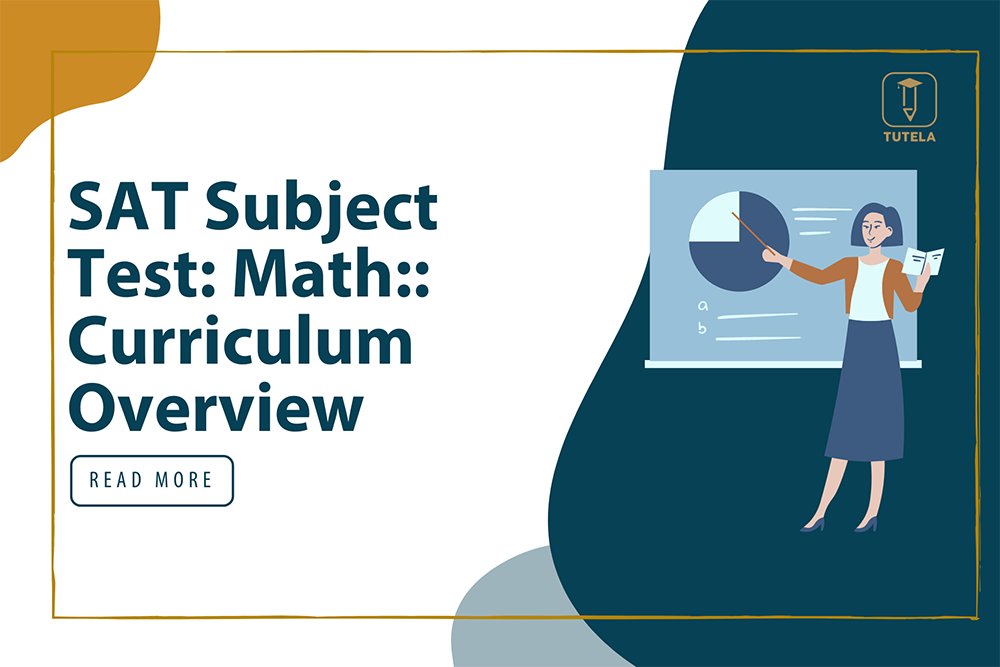
The SAT Subject Test Math 2 covers topics that would be covered in one year of geometry and two years of algebra—plus pre-calculus and trigonometry. However, the geometry concepts learned in a typical geometry class are only assessed indirectly through more advanced geometry topics such as coordinate and three-dimensional geometry.
Below is a chart with topics and percentage breakdowns:
|
Topics and Subtopics |
% of Math 2 SAT Subject Test | Approximate # of Questions |
| Number and Operations | 10-14% | 5-7 |
| Operations, ratio and proportion, complex numbers, counting, elementary number theory, matrices, sequences, series, vectors | ||
| Algebra and Functions | 48-52% | 24-26 |
| Expressions, equations, inequalities, representation and modelling, properties of functions (linear, polynomial, rational, exponential, logarithmic, trigonometric, inverse trigonometric, periodic, piece-wise, recursive, parametric) | ||
| Geometry and Measurement | 28-32% | 14-16 |
| Coordinate: lines, parabolas, circles, ellipses, hyperbolas, symmetry, transformations, polar coordinates | 10-14% | 5-7 |
| Three-dimensional: solids, surface area and volume (cylinders, cones, pyramids, spheres, prisms), coordinates in three dimensions | 4-6% | 2-3 |
| Trigonometry: right triangles, identities, radian measure, the law of cosines, the law of sines, equations, double angle formula | 12-16% | 6-8 |
| Data Analysis, Statistics, and Probability | 8-12% | 4-6 |
| Mean, median, mode, range, interquartile range, standard deviation, graphs and plots, least squares regression (linear, quadratic, exponential), probability |
Format of the Test
The test contains 50 multiple-choice questions with a duration of one hour. All questions have five answer choices. Students are awarded 1 point for every correct answer, lose 1/4th of a point for each incorrect answer, and receive 0 points for questions left blank.
Use of Calculators
The College Board states that a calculator may be useful or necessary for about 55-60% of the questions on the test. It encourages students to use a graphing calculator rather than a scientific calculator since the test was developed with the expectation that most students are using graphing calculators.
The College Board discourages the use of calculators that have a QWERTY format keyboard in their Mathematics Level-2 test, students are also advised that they will not be allowed any electrical outlet, paper tape, non-traditional methods of input (such as a stylus), or are part of a communication device (such as laptops or cell phones).
How to Prepare?
The College Board advises the students to have a rigorous practice of four years of mathematics (two years of algebra, one year of geometry, and one year of either precalculus or trigonometry).
While the pre-calculus or trigonometry course may be good preparation for this test, students may need to buy extra resource materials if they want a score beyond 700. This exam covers several years of mathematics and demands students to work quickly and efficiently for a high score.
Scoring System
For each of the 50 multiple-choice questions, students receive 1 point for every correct answer, lose 1/4th of a point for each incorrect answer, and receive 0 points for questions left blank. This creates a raw score, which is then converted into a scaled score. This conversion between the numbers varies depending on the difficulty of a particular test administration. The scaled score is the score that is reported to either students or colleges, and ranges from 200 to 800, with 800 being the best possible score.
Scoring 800 on the SAT Math 2 Subject Test
It is also important to make sure the practice questions are relevant to the SAT Math II Subject Test. The questions need to have been written in the same style as in the test, have equal difficulty levels, and have a degree of organization that allows students to progress to harder and harder questions with more practice.
Final Takeaways:
1. After reviewing their mock tests, students might discover there are some aspects of the test that they find hard to get their heads around. They may find it hard to finish on time, or find it difficult to get some topics consistently correct; or may be making too many silly mistakes; most of these issues are normally corrected through practice.
2. Speak to your math teacher– They are an expert in the field. What’s more, nobody understands your math ability as well as your teacher, so he or she can provide you with indispensable feedback and advice tailored to your learning and test-taking style.
3. Talk to your seniors or your friends who have already taken the Math SAT II Test – They have been in your shoes and will be the most relatable.
4. Get some professional help to explain in greater detail some topics you are finding particularly difficult
In addition to this, if you need any help with the preparations, let us know by filling in Tutela’s Student Assistance Form